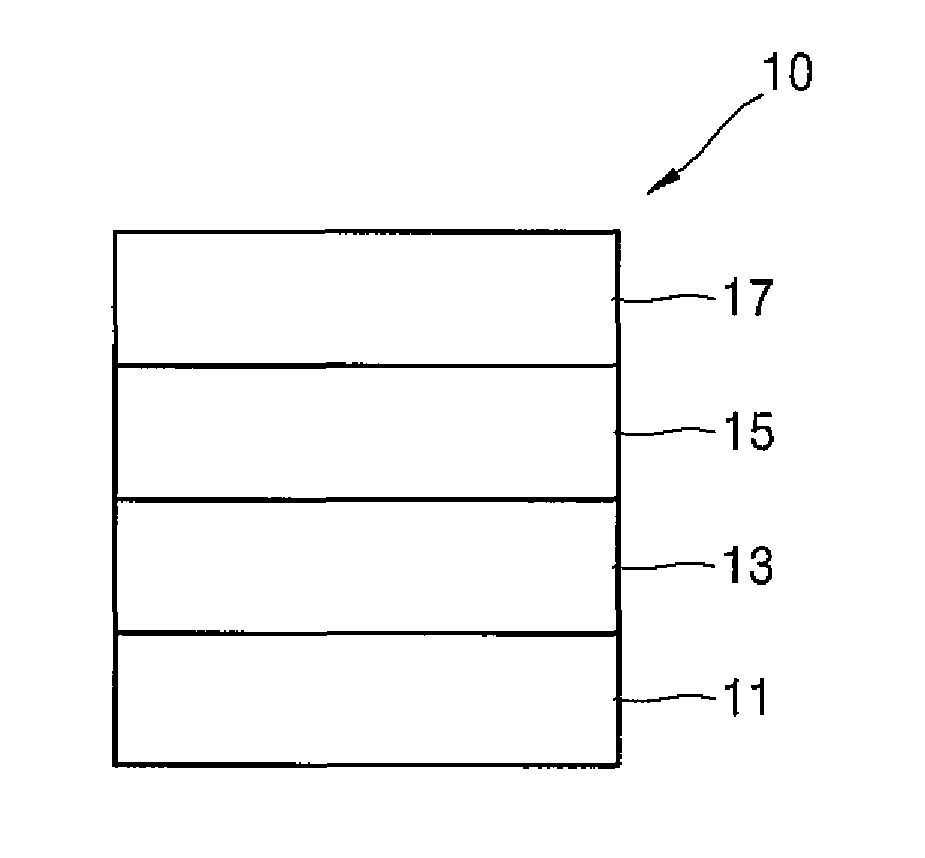Organic light-emitting device emitting delayed fluorescence
a light-emitting device and organic technology, applied in the direction of organic semiconductor devices, solid-state devices, semiconductor devices, etc., can solve the problems of reducing the charge transport characteristics, and achieve the effect of improving the roll-off characteristics, reducing the efficiency roll-off characteristics, and high efficiency
- Summary
- Abstract
- Description
- Claims
- Application Information
AI Technical Summary
Benefits of technology
Problems solved by technology
Method used
Image
Examples
example 1
[0181]As an anode, an ITO glass substrate having a thickness of 15 Ω / cm2 (1200 Å) and made by Corning Inc. was cut to a size of 50 mm×50 mm×0.5 mm and then, sonicated in acetone, in isopropyl alcohol, and in pure water, for 15 minutes in each, and then, cleaned using UV ozone for 30 minutes. Next, methylated-NPD was vacuum deposited on an upper portion of the ITO glass substrate to form a hole injection layer having a thickness of 600 Å and then, TAPC was vacuum deposited on an upper portion of the hole injection layer to form a hole transport layer having a thickness of 300 Å. Compound H5 and Compound H1 were used as a host in a weight ratio of 90:10 (Compound H5:Compound H1), and the resulting host and a blue emitting dopant, which was Compound D1, were co-deposited on an upper portion of the hole transport layer in a weight ratio of 94:6 (host:dopant) to form an emission layer having a thickness of 300 Å. TPBi was vacuum deposited on an upper portion of the emission layer to form...
example 2
[0182]An organic light-emitting device was manufactured in the same (or substantially the same) manner as in Example 1, except that Compound H6 and Compound H3 were used as a host of an emission layer in a weight ratio of 90:10 (Compound H6:Compound H3) instead of Compound H5 and Compound H1 in a weight ratio of 90:10.
example 3
[0183]An organic light-emitting device was manufactured in the same (or substantially the same) manner as in Example 1, except that Compound H6 and Compound H7 were used as a host of an emission layer in a weight ratio of 90:10 (Compound H6:Compound H7) instead of Compound H5 and Compound H1 in a weight ratio of 90:10.
PUM
 Login to View More
Login to View More Abstract
Description
Claims
Application Information
 Login to View More
Login to View More - R&D
- Intellectual Property
- Life Sciences
- Materials
- Tech Scout
- Unparalleled Data Quality
- Higher Quality Content
- 60% Fewer Hallucinations
Browse by: Latest US Patents, China's latest patents, Technical Efficacy Thesaurus, Application Domain, Technology Topic, Popular Technical Reports.
© 2025 PatSnap. All rights reserved.Legal|Privacy policy|Modern Slavery Act Transparency Statement|Sitemap|About US| Contact US: help@patsnap.com



